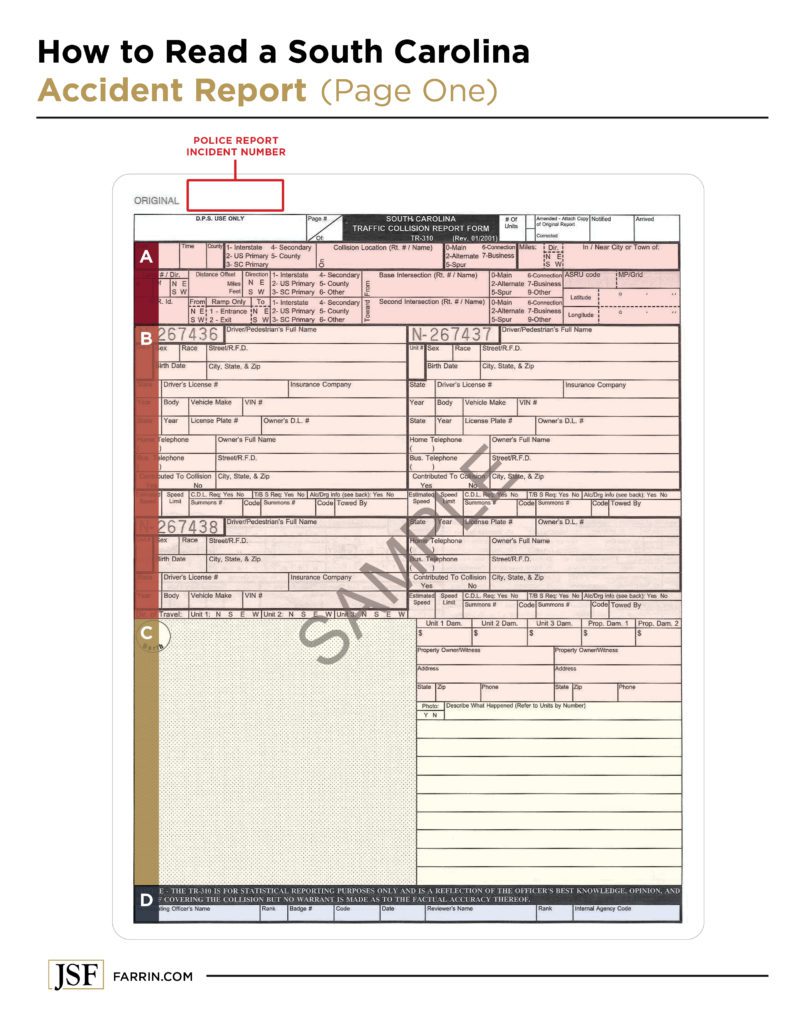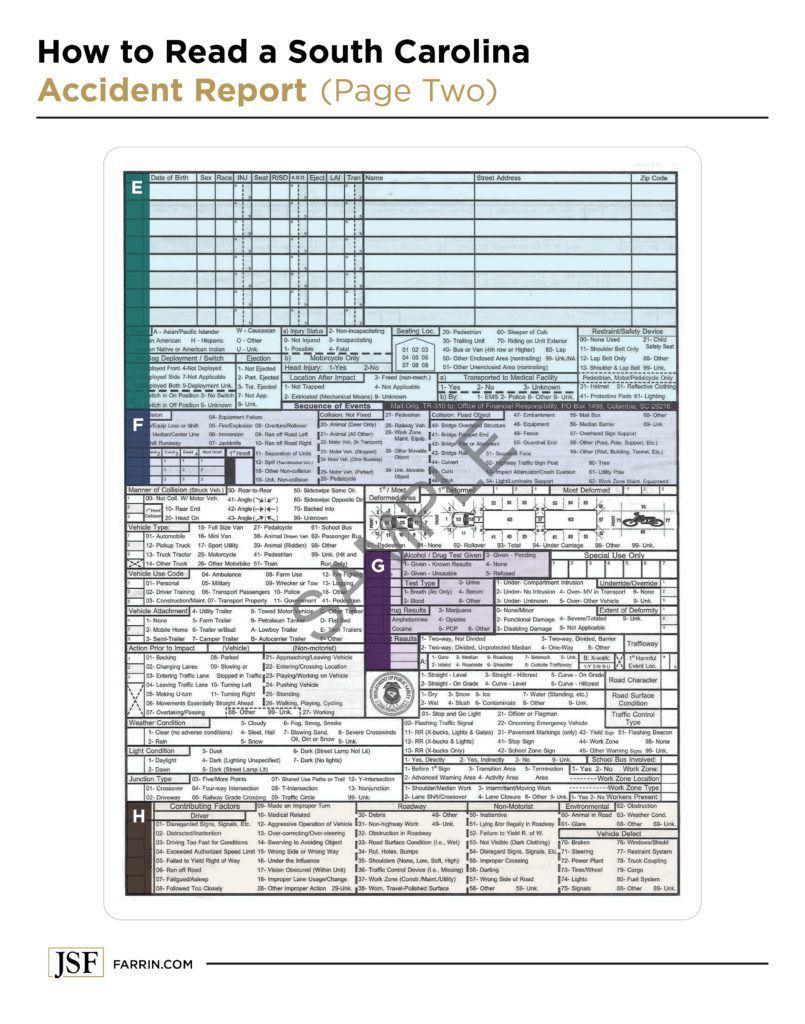
This page refers to How to Read South Carolina Accident Police Report.
Since laws differ between states, if you are located in North Carolina, please click here.
How to Read South Carolina Accident Police Report
When you’re in a car accident in South Carolina, the police officer at the scene fills out a report that they file with the state. Many people believe that what’s in an accident report will determine who is at fault and how much they might be able to seek as compensation for injuries sustained in the accident.
That’s not necessarily true. While the accident report represents the evidence and conclusions of the officer on the scene, that doesn’t make it infallible. Some insurance companies may be quick to seize on small details or facts that, without proper context, could damage your attempt to recover compensation.
With that said, being able to properly read a South Carolina police report could help you, especially if there’s an error or omission you believe is important.
How to Read a South Carolina Accident Report, Page One
Where Is the Incident Number on an SC Police Report?
[View the “Where Is the Incident Number” section of the video by clicking here.]
You can locate the police report incident number in the upper left corner of the South Carolina police report. The Department of Public Safety adds the incident number on the police report above the rectangular box with the words “D.P.S. USE ONLY” at the top left-hand corner of the form above Section A. You can use this number to identify your case when talking with others about it.
A: Location Information
[View the “Location Information” section of the video by clicking here.]
There are two pages – front and back – to a South Carolina accident report. At the top of the first page is the location information for where the accident occurred. Verify that the lanes, location, intersections, and travel directions are correct.
B: Personal Information
[View the “Personal Information” section of the video by clicking here.]
Below the accident location, there is space for the personal information of the drivers, passengers, and pedestrians in the accident. It should list everyone involved, insurance companies, drivers’ license numbers, and so on. It also lists whether or not the officer believes the person was speeding and/or contributed to the accident. Make sure your information is accurate.
C: Accident Description
[View the “Accident Description” section of the video by clicking here.]
Continuing down the page is an area for the police officer to describe the accident, including space for a diagram or drawing.
D: Police Officer Information
At the bottom of page one of the police report is the officer’s information, including badge number and rank. The officer’s information may be important for a variety of reasons.
How to Read a South Carolina Accident Report, Page Two
E: Injury Information
[View the “Injury Information” section of the video by clicking here.]
The top of page two of the South Carolina police report is dedicated to listing the condition of the people involved in the accident. This can range from “not injured” all the way to “fatal.” It has fields for seat belt use, airbag deployment, whether the person was ejected from the vehicle, and if the person was taken to the hospital. It has provisions for pedestrians and cyclists as well.
This is not a declaration, but an observation. Police officers are not doctors, and just because you did not appear injured at the scene does not mean you did not suffer an injury in the accident. This is why we encourage people to seek treatment as soon as possible after an accident. Even if you “feel fine,” go and see your physician. You may not be as fine as you think, and after the adrenaline of being in an accident wears off, you may feel very differently. Injuries, such as whiplash, may take days for symptoms to appear.
F: Sequence of Events
[View the “Sequence of Events” section of the video by clicking here.]
Below the injury fields is a section where the officer can assemble the accident timeline as they understand it based on evidence and witness reports at the scene. If this information is not as you remembered it, or if there is an error, an insurance company could use it to limit or deny you compensation.
G: Presence of Alcohol or Drugs
There is a section on page two that allows a police officer to note the presence of drugs or alcohol, and whether or not sobriety tests, breath tests, and so on were administered. This could be a critical section for a few reasons. You can learn more on our dedicated page about South Carolina DUI.
H: Contributing Factors
[View the “Contributing Factors” section of the video by clicking here.]
Toward the bottom of page two of the police report from an accident, there is a very important section where the officer can note contributing factors to the crash. This can be very important in determining the burden of fault in your case. The form has fields for many causes and forms of negligence, including distracted driving, failure to yield, and driving on the wrong side of the road. There’s also a section for road hazards and environmental factors, including debris and obstructions in the road.
While this can be very helpful to your case, it’s something that can be argued – by you or by the insurance company. What’s noted in this section is what the officer has discovered, not necessarily everything that can be discovered. In any case, this section is important. If you disagree with what’s listed, you should contact an experienced South Carolina car accident attorney about your case.
Vehicle Defects
The last part of the report is an area where the officer can note any defects in the vehicles involved in the crash. These may have no apparent impact on the crash, or they may be the determining factor. Again, these are what the officer can see, though it is not necessarily conclusive.
Obtaining an Accident Report in South Carolina
The South Carolina DMV does not automatically send a copy of the accident report to those involved in a crash. It is added to the driving record, but if you want a copy of the police report, you have to fill out a Request for Collision Report (Form FR-50) and pay for it.
Can’t view the video above? Click here to watch on our YouTube channel.
Contact the Law Offices of James Scott Farrin if You Have Questions or Concerns
The police accident report is an official record of the crash, but that doesn’t mean it is 100% accurate. Police officers are human, and they’re recording what they can find at the scene while trying to manage the situation.
And if you were injured in the accident, you want to ensure that the report is accurate! The insurance company may seize on mistaken information and use it to lower their possible payout or even deny your claim. Call us at 1-866-900-7078 or contact us online for a free case evaluation. Our team is ready to listen!



